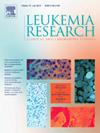Phase 1 first-in-human dose-expansion study of the oral SF3B1 modulator H3B‑8800 in lower-risk myelodysplastic syndrome
IF 2.1
4区 医学
Q3 HEMATOLOGY
引用次数: 0
Abstract
Objective
To assess the efficacy and safety of H3B-8800 at two dose regimens in patients with transfusion-dependent lower-risk myelodysplastic neoplasms (LR-MDS) with somatic SF3B1 mutations.
Methods
In this Phase 1 multicenter study, adults with LR-MDS with SF3B1 mutations were enrolled in two expansion cohorts: 10 mg and 5 mg twice a day (BID). Patients were red blood cell (RBC) transfusion-dependent, defined as ≥ 4 RBC units in 8 weeks in cohort 1 and ≥ 3 RBC units in ≥ 2 transfusions in 16 weeks in cohort 2 (patients naïve to hypomethylating agents and lenalidomide). The primary endpoint was RBC transfusion independence (TI) ≥ 8 weeks. Adverse events (AEs) during treatment were assessed in each dose cohort.
Results
In cohort 1 (n = 7), the H3B-8800 starting dose was reduced to 5 mg BID in the last two patients due to thrombocytopenia; this dose was selected for cohort 2 (n = 36). The median number of 28-day cycles on therapy was 2.7 and 4.8, with dose adjustments due to AEs in five (71.4 %) and 25 (69.4 %) patients in cohorts 1 and 2, respectively. The most frequently experienced AE was diarrhea. Two (28.6 %) patients in cohort 1 and seven (19.4 %) in cohort 2 developed atrial fibrillation. Two patients in each cohort achieved one interval of RBC-TI ≥ 8 weeks.
Conclusion
The AE profile was similar to that reported previously, with a slightly higher incidence of atrial fibrillation. However, the low RBC-TI rate suggests insufficient efficacy of H3B-8800 at the dose levels tested. Further exploration of dosing schedules is warranted.
Trial Registration Number and Date
NCT02841540. 22 July 2016
口服SF3B1调节剂H3B - 8800治疗低风险骨髓增生异常综合征的i期首次人体剂量扩展研究
目的评价H3B-8800在两种剂量方案下治疗伴有SF3B1体细胞突变的输血依赖性低风险骨髓增生异常肿瘤(LR-MDS)患者的疗效和安全性。方法在这项1期多中心研究中,患有SF3B1突变的成年lmds患者被纳入两个扩展队列:10 mg和5 mg,每天两次(BID)。患者是红细胞(RBC)输注依赖的,在队列1中定义为8周输注≥ 4个红细胞单位,在队列2中定义为16周输注≥ 2个红细胞单位≥ 3个红细胞单位(患者naïve对低甲基化药物和来那度胺)。主要终点为RBC输血独立性(TI)≥ 8周。在每个剂量组中评估治疗期间的不良事件(ae)。结果在队列1 (n = 7)中,由于血小板减少,最后2例患者的H3B-8800起始剂量降至5 mg BID;队列2选择该剂量(n = 36)。治疗28天周期的中位数分别为2.7天和4.8天,在队列1和队列2中分别有5名(71.4 %)和25名(69.4% %)患者因ae而进行剂量调整。最常见的AE是腹泻。队列1中2例(28.6 %)和队列2中7例(19.4 %)发生心房颤动。每个队列中有2例患者达到一次RBC-TI≥ 8周的间隔。结论AE的特征与之前报道的相似,心房颤动的发生率略高。然而,低RBC-TI率表明,在测试的剂量水平下,H3B-8800的疗效不足。进一步探索给药方案是必要的。试验注册号和日期:02841540。2016年7月22日
本文章由计算机程序翻译,如有差异,请以英文原文为准。
求助全文
约1分钟内获得全文
求助全文
来源期刊

Leukemia research
医学-血液学
CiteScore
4.00
自引率
3.70%
发文量
259
审稿时长
1 months
期刊介绍:
Leukemia Research an international journal which brings comprehensive and current information to all health care professionals involved in basic and applied clinical research in hematological malignancies. The editors encourage the submission of articles relevant to hematological malignancies. The Journal scope includes reporting studies of cellular and molecular biology, genetics, immunology, epidemiology, clinical evaluation, and therapy of these diseases.
 求助内容:
求助内容: 应助结果提醒方式:
应助结果提醒方式:


